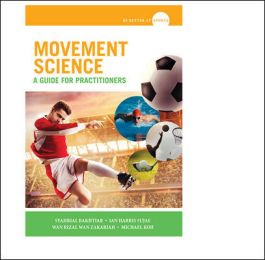MOVEMENT SCIENCE A GUIDE FOR PRACTITIONERS
1st Edition
9814821659
·
9789814821650
© 2020 | Published: December 31, 2019
Movement Science: A Guide for Practitioner aims to provide readers with a grounding of the science of movement from the perspectives of Biomechanics and Motor Control Learning and Development. Intended for all movement enthusiasts from sports hobbyis…
Read More
Receive via shipping:
- Colour, print bound version of the complete text
CONTENTS
CHAPTER 1- THE WHY, WHAT AND HOW OF TECHNIQUE ANALYSES Why technique analysis?
What is technique analysis?
How is technique analysis done?
CHAPTER 2- TECHNIQUE ANALYSIS
Observation of Performance
Systematic Observation
Analysis of Movement
Evaluation of Movement
CHAPTER 3- KINEMATICS – DESCRIBING MOTION
Kinematic Quantities
Angular Quantities of Motion
Linear and Angular Motion Relationship
Implications
CHAPTER 4- KINETICS – CAUSES OF MOTION
Mass, inertia and moments of inertia
Force, Momentum, Torque and Angular Momentum
Linear and Angular Laws of motion
Implications
CHAPTER 5- APPLYING SPORTS BIOMECHANICS TO PE AND SPORTS
Balance and Stability
Kinetic Chain
Stretch-shorten Cycle
Projectile Motion
Fluid Mechanics
Magnus Effect
CHAPTER 6- THE DYNAMICAL SYSTEMS THEORY AND THE CONSTRAINTS-LED APPROACH
Properties of Complex Systems
Constraints-led Approach (CLA)
Practical Implications
CHAPTER 7- MOTOR DEVELOPMENT AND FUNDAMENTAL MOVEMENT SKILLS
Movements Phase
Examples of the Three Stages in Different Movements
Sports-specific Period
Assessing Motor Development in Children
Sample of TGMD-3
Sample of BOT-2
CHAPTER 8- PUTTING IT ALL TOGETHER – A CASE STUDY
A Case Study
Step 1: Determine the Quality of Movement
Step 2: Determine Performance Variations as a Reflection of the Quality of Movement
Step 3: Quantify Changes in Performance Variation and Outcome Measures
Step 4: Measure Progression of Training Variations Using Non-linear Pedagogy
Step 5: Establish the Utilisation of Correct Technique
INDEX
CHAPTER 1- THE WHY, WHAT AND HOW OF TECHNIQUE ANALYSES Why technique analysis?
What is technique analysis?
How is technique analysis done?
CHAPTER 2- TECHNIQUE ANALYSIS
Observation of Performance
Systematic Observation
Analysis of Movement
Evaluation of Movement
CHAPTER 3- KINEMATICS – DESCRIBING MOTION
Kinematic Quantities
Angular Quantities of Motion
Linear and Angular Motion Relationship
Implications
CHAPTER 4- KINETICS – CAUSES OF MOTION
Mass, inertia and moments of inertia
Force, Momentum, Torque and Angular Momentum
Linear and Angular Laws of motion
Implications
CHAPTER 5- APPLYING SPORTS BIOMECHANICS TO PE AND SPORTS
Balance and Stability
Kinetic Chain
Stretch-shorten Cycle
Projectile Motion
Fluid Mechanics
Magnus Effect
CHAPTER 6- THE DYNAMICAL SYSTEMS THEORY AND THE CONSTRAINTS-LED APPROACH
Properties of Complex Systems
Constraints-led Approach (CLA)
Practical Implications
CHAPTER 7- MOTOR DEVELOPMENT AND FUNDAMENTAL MOVEMENT SKILLS
Movements Phase
Examples of the Three Stages in Different Movements
Sports-specific Period
Assessing Motor Development in Children
Sample of TGMD-3
Sample of BOT-2
CHAPTER 8- PUTTING IT ALL TOGETHER – A CASE STUDY
A Case Study
Step 1: Determine the Quality of Movement
Step 2: Determine Performance Variations as a Reflection of the Quality of Movement
Step 3: Quantify Changes in Performance Variation and Outcome Measures
Step 4: Measure Progression of Training Variations Using Non-linear Pedagogy
Step 5: Establish the Utilisation of Correct Technique
INDEX
Movement Science: A Guide for Practitioner aims to provide readers with a grounding of the science of movement from the perspectives of Biomechanics and Motor Control Learning and Development. Intended for all movement enthusiasts from sports hobbyists to competitive athletes as well as physical education teachers and coaches, this book sets out to enhance an awareness and promote the adoption of strategies that could guide practitioners to be better at sports. The approach for this book Movement Science: A Guide for Practitioner is straightforward using a “why”, “what” and “how” framework to make it easy to read and to understand an otherwise highly technical content. In this way, we hope readers will implement the theories and concepts in their regular practice of sports and be better at it.

